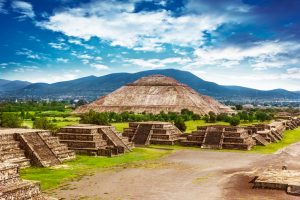 Torrential rains saturated the grounds at Teotihuacan (pronounce it tay-oh-tee-wah-KAHN) on an autumn day in 2003. The pre-Aztec ruins, located just 30 miles from Mexico City, became so waterlogged that a gapping sinkhole opened up at the dig site at the base of the Temple of the Plumed Serpent—a large pyramid at the southeast sector of Teotihuacan. Sergio Gomez, the archaeologist who discovered the mess, later recalled thinking, “How exactly are we going to fix this?” After lowering himself down into the hole via rope, Gomez realized that the “mess” he’d been fretting over was actually one of the most significant discoveries at Teotihuacan. The painstaking explorations that would follow yielded a few puzzles that have yet to be solved—namely, the existence of liquid mercury and the formation of hundreds of mysterious yellow orbs.
Torrential rains saturated the grounds at Teotihuacan (pronounce it tay-oh-tee-wah-KAHN) on an autumn day in 2003. The pre-Aztec ruins, located just 30 miles from Mexico City, became so waterlogged that a gapping sinkhole opened up at the dig site at the base of the Temple of the Plumed Serpent—a large pyramid at the southeast sector of Teotihuacan. Sergio Gomez, the archaeologist who discovered the mess, later recalled thinking, “How exactly are we going to fix this?” After lowering himself down into the hole via rope, Gomez realized that the “mess” he’d been fretting over was actually one of the most significant discoveries at Teotihuacan. The painstaking explorations that would follow yielded a few puzzles that have yet to be solved—namely, the existence of liquid mercury and the formation of hundreds of mysterious yellow orbs.
Why liquid mercury is significant
Gomez and his team of archaeologists found traces of liquid mercury in the main tunnel underneath the Temple of the Plumed Serpent. The odds are strongly against that being a natural phenomenon. In nature, mercury exists in cinnabar rock, aka mercury ore. The mercury has to be extracted from the rock and purified to eliminate the sulfur. The easiest way to accomplish this is to heat the cinnabar to 674 degrees Fahrenheit—the boiling point of mercury—and collect the mercury vapors. The vapors are then condensed and what’s left is liquid mercury.
This is significant because in nature, mercury exists primarily in the cinnabar rock, and rarely as a native metal. This means the ancient civilization who built Teotihuacan had to have gone through the laborious process of creating liquid mercury. Archaeologists have theorized that the mercury served some symbolic or ritualistic purpose, but it’s likely that we’ll never know for sure exactly why the ancients made it and kept it under a temple.
What purpose could the orbs have had?
The hundreds of small, metallic orbs—which researchers have named “disco balls”—have been equally puzzling. In an unusual turn of events worthy of an Indiana Jones movie, the archaeologists working under the temple used two robotic probes to poke around some of the rooms. These probes found the orbs, which range from four to 12 centimeters in diameter. Researchers found the orbs were made from clay, and then were covered with pyrite, or fool’s gold. Over the millennia, the pyrite oxidized and became jarosite—a crusty amber mineral. It’s been suggested that the orbs served some sort of religious or ritualistic purpose, but this is only speculation.
Sheets of mica
Teotihuacan is puzzling for another reason. On top of the Pyramid of the Sun, researchers found a thick sheet of mica. Mica was also present on the floors of subterranean chambers at that pyramid. No other archaeological sites in the country or, for that matter, the continent, are known to have been built with mica. What makes this feature curious is that the mica appears to have originated in Brazil. How it found its way to present-day Mexico City and why it was used are questions that may never be answered.
Experience the mystery of the ancient past for yourself. Sea Side Reservations makes it easy to book comfortable, safe accommodations throughout Mexico. Since 2001, we’ve been rated #1 for owner and guest satisfaction. Our professional property managers validate all properties with our certified 5 star rating system. Get started planning your next adventure today!
More on the mysteries of Teotihuacan:
- Smithsonian, A Secret Tunnel Found in Mexico May Finally Solve the Mysteries of Teotihuacán, http://www.smithsonianmag.com/history/discovery-secret-tunnel-mexico-solve-mysteries-teotihuacan-180959070/
- Archaeology, Mythological Mercury Pool, http://www.archaeology.org/issues/200-1601/features/3958-mexico-teotihuacan-mercury


